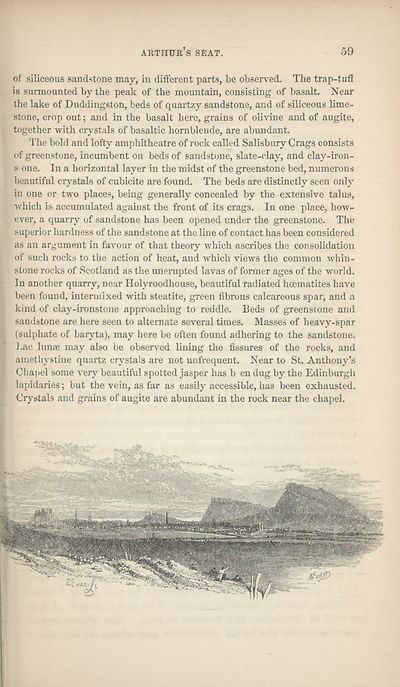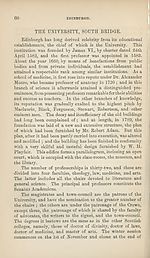Download files
Complete book:
Individual page:
Thumbnail gallery: Grid view | List view

ARTHURS S
59
iliceous sandstone may, in different parts, be observed. The trap-tuff
irmounted by the peak of the mountain, consisting of basalt. Near
ake of Duddingston, beds of quartzy sandstone, and of siliceous lime-
e, crop out; and in the basalt here, grains of olivine and of augite,
ther with crystals of basaltic hornblende, are abundant.
I'he bold and lofty amphitheatre of rock called Salisbury Crags consists
reenstone, incumbent on beds of sandstone, slate-clay, and clay-iron-
e. In a horizontal layer in the midst of the greenstone bed, numerous
ne or two places, being generally concealed by the extensive talus,
ch is accumulated against the front of its crags. In one place, how-
■, a quarry of sandstone has been opened under the greenstone. The
irior hardness of the sandstone at the line of contact has been considered
n argument in favour of that theory which ascribes the consolidation
uch rocks to the action of heat, and which views the common whin-
,e rocks of Scotland as the unerupted lavas of former ages of the world,
nother quarry, near Holyroodhouse, beautiful radiated hoematites have
i found, intermixed with steatite, green fibrous calcareous spar, and a
1 of clay-ironstone approaching to reddle. Beds of greenstone and
istone are here seen to alternate several times. Masses of heavy-spar
phate of baryta), may here be often found adhering to the sandstone,
lunse may also be observed lining the fissures of the rocks, and
crystals are not unfrequent. Near to St. Anthony’s
autiful spotted jasper has b en dug by the Edinburgh
rein, as far as easily accessible, has been exhausted,
of augite are abundant in the rock near the chapel.
Chapel s<
lapidaries;
59
iliceous sandstone may, in different parts, be observed. The trap-tuff
irmounted by the peak of the mountain, consisting of basalt. Near
ake of Duddingston, beds of quartzy sandstone, and of siliceous lime-
e, crop out; and in the basalt here, grains of olivine and of augite,
ther with crystals of basaltic hornblende, are abundant.
I'he bold and lofty amphitheatre of rock called Salisbury Crags consists
reenstone, incumbent on beds of sandstone, slate-clay, and clay-iron-
e. In a horizontal layer in the midst of the greenstone bed, numerous
ne or two places, being generally concealed by the extensive talus,
ch is accumulated against the front of its crags. In one place, how-
■, a quarry of sandstone has been opened under the greenstone. The
irior hardness of the sandstone at the line of contact has been considered
n argument in favour of that theory which ascribes the consolidation
uch rocks to the action of heat, and which views the common whin-
,e rocks of Scotland as the unerupted lavas of former ages of the world,
nother quarry, near Holyroodhouse, beautiful radiated hoematites have
i found, intermixed with steatite, green fibrous calcareous spar, and a
1 of clay-ironstone approaching to reddle. Beds of greenstone and
istone are here seen to alternate several times. Masses of heavy-spar
phate of baryta), may here be often found adhering to the sandstone,
lunse may also be observed lining the fissures of the rocks, and
crystals are not unfrequent. Near to St. Anthony’s
autiful spotted jasper has b en dug by the Edinburgh
rein, as far as easily accessible, has been exhausted,
of augite are abundant in the rock near the chapel.
Chapel s<
lapidaries;
Set display mode to:
![]() Universal Viewer |
Universal Viewer | ![]() Mirador |
Large image | Transcription
Mirador |
Large image | Transcription
| Antiquarian books of Scotland > Scotland/Scots > Black's picturesque tourist of Scotland > (111) |
|---|
| Permanent URL | https://digital.nls.uk/130029522 |
|---|
| Description | Thousands of printed books from the Antiquarian Books of Scotland collection which dates from 1641 to the 1980s. The collection consists of 14,800 books which were published in Scotland or have a Scottish connection, e.g. through the author, printer or owner. Subjects covered include sport, education, diseases, adventure, occupations, Jacobites, politics and religion. Among the 29 languages represented are English, Gaelic, Italian, French, Russian and Swedish. |
|---|

